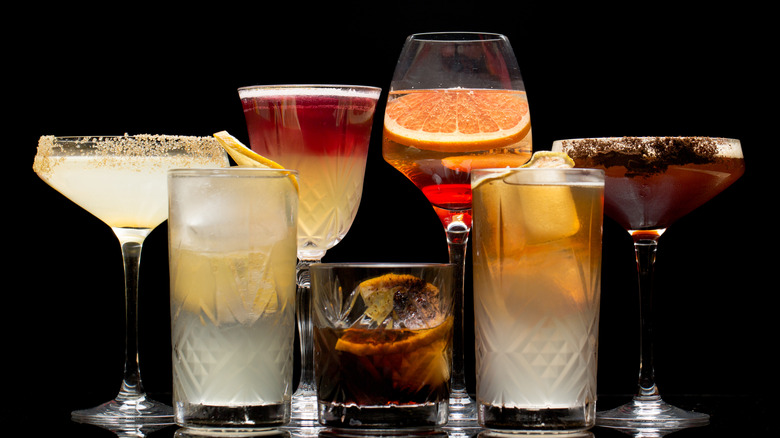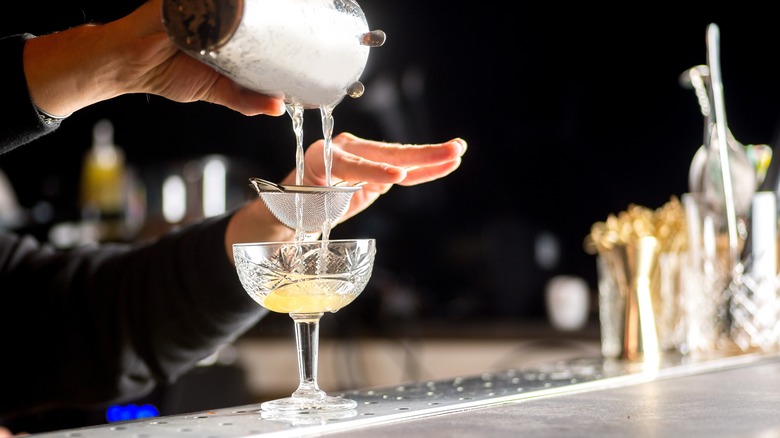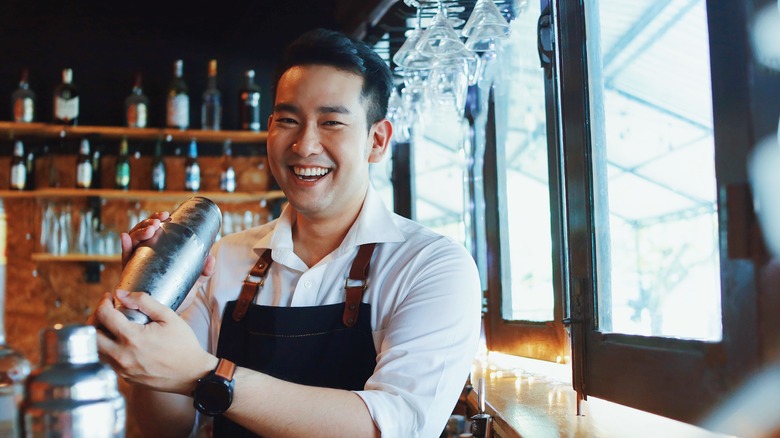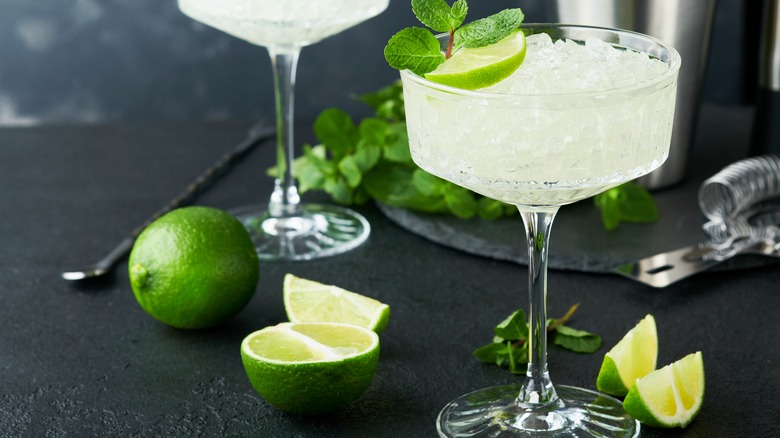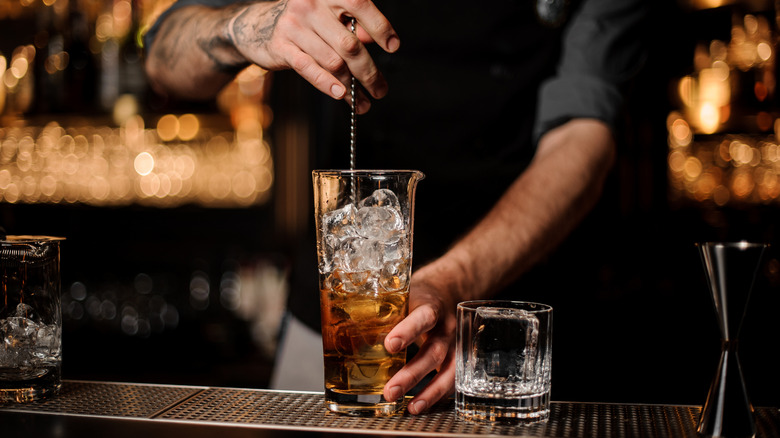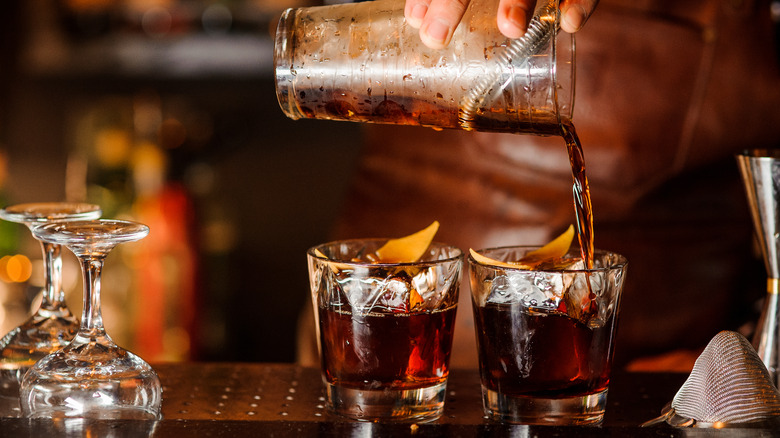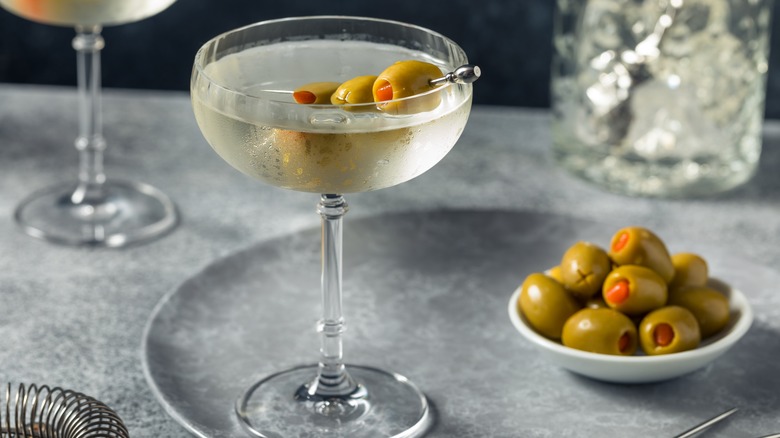How Long Should You Shake A Cocktail (& Which Should Be Stirred Instead)?
Mixing drinks can be as easy or complex as you want it to be. Still, there are a few rules you should abide by, whether you're a professional bartender or simply making drinks for friends at home.
The basics involve understanding how to properly shake and stir drinks. Mixing drinks isn't difficult, but it does require some know-how and a touch of finesse. For instance, the length of time that you spend mixing the drink is critical, as is nailing the technique. Though he doesn't mix his own, even James Bond gets it wrong — martinis should be stirred, not shaken.
Shaking and stirring produce different results, but they serve similar purposes. Both are means of combining the ingredients, chilling the drink, and diluting the alcohol with water. That's right, you actually want your cocktails diluted; while nobody wants an excessively watered-down drink, cocktails will have an unbalanced flavor if you don't dilute them. While the exact amount of dilution depends on the drink, pros generally recommend 25% to 30% dilution — though some drinks may require up to 45%.
When to shake cocktails
You may have heard that, if a drink contains citrus, it should be shaken. While that's a good rule of thumb, it's not the whole story. Yes, you should generally shake cocktails that contain citrus, but the rule also applies to drinks that contain dairy, fruit juices, or other fresh ingredients. Drinks made with egg white, like whiskey sours, should be shaken, too.
Shaking helps thoroughly blend the ingredients and balances out harsh flavors by diluting the drink. If your drink contains thicker liquids, like syrups, it might benefit from a shake. Shaking also aerates drinks, forcing tiny air bubbles into the liquid. While shaken drinks don't have the same fizz that you get from carbonation, they do have a lively, frothy feel and an icy kick. If you stir a drink that's meant to be shaken — like a margarita or daiquiri — it might feel flat.
Not all drinks should be shaken, though. Avoid shaking drinks that are entirely alcoholic, and never shake carbonated drinks unless you want a mess. However, some shaken drinks are topped off with bubbly beverages like prosecco, soda, or tonic as a final step.
How long to shake cocktails
Shaking is a pretty quick process: according to experiments from the International Culinary Center, you'll only need to shake for around 12 seconds to fully chill the drink. At that point, it's approaching thermal equilibrium, and shaking longer will only make a few degrees of difference. Drinks served over ice chill even faster. To avoid over-diluting these drinks, shake for just 5 to 7 seconds to mix the ingredients and achieve the right texture.
Cocktails made with egg white require more of a workout and a little extra technique. To get that perfect head of foam, use a dry shake or reverse dry shake and agitate the drink for 30 to 60 seconds. A dry shake involves shaking the ingredients at room temperature until the egg starts to foam, then adding ice and shaking again to chill the drink. The reverse dry shake involves shaking the drink with ice first, then straining out the ice and shaking the drink again. The reverse-dry shake produces more foam than a dry shake, but it's a bigger hassle. If you're a home bartender — or operating under a time crunch — you might want to stick with a dry shake because both are just aiming to produce a foamier head than a standard shake.
And you never recycle used ice, so toss it out once it's shaken a drink.
Cocktails that should be shaken
Many famously fruity drinks, like cosmopolitans, margaritas, and daiquiris, are shaken. Clover Club cocktails, amaretto sours, and gin fizzes are shaken, too (the frothy egg white head is a dead giveaway).
Generally, shaken and stirred drinks have different flavor profiles. You'll notice that many of these drinks are light and fresh, the kind of cocktails that go down easy at summer parties. Since shaken drinks are more heavily diluted and often contain fresh-tasting ingredients like citrus, they generally don't pack as much of a punch as stirred drinks.
Even martinis can be served shaken in some circumstances. James Bond's instructions for a classic martini may be incorrect, but his Vesper martini has become a popular variant. While some bartenders simply ignore Bond's instructions, others argue that a little extra dilution does a service to an exceptionally strong drink.
Bartenders disagree as to whether or not dirty martinis should be shaken; some argue that shaking helps combine the dense olive brine with the other ingredients. Other martini variations — the kind that infuriate martini purists, like the French and espresso martini — require shaking too. When picking the right mixing technique, the ingredients matter more than the name.
When to stir cocktails
While you should know to avoid Bond's faux pas by shaking martinis, remembering that Bond was wrong can help you identify other drinks that should be stirred, too. If a drink mixes booze with booze, chances are that it's meant to be stirred. In these drinks, alcohol takes center stage — it's the main source of flavor. If you shake, you risk over-diluting the drink and drowning out delicate notes. You should also keep in mind that shaking aerates cocktails, a desired effect for some drinks, but not for others. While a frothy texture may be ideal for a daiquiri, it would be odd for an old fashioned.
Many bartenders argue that you shouldn't shake gin-based drinks at all. Like perfume and fine wine, gin has top notes — the subtle botanical flavors that make it unique. These notes are the first to dissipate when the liquid is exposed to air. Aerating the gin causes it to lose these top notes, "bruising" it and dulling the flavor. That said, shaking is unavoidable for some gin drinks. After all, getting a foamy egg white head on your gin fizz is more important than maintaining the spirit's integrity.
How long to stir cocktails
There's no easy answer to how long you should stir a cocktail, as the time it takes can vary significantly. Some mixologists cite 18-25 seconds as the sweet spot; others claim you should stir for up to a full minute. Stirring takes longer than shaking, and a stirred drink won't be as cold. A drink needs to be stirred for a full two minutes to reach the same temperature as a standard shaken drink.
The key to deciding the length of your stir is your ice. Ice is one of the most important factors in any cocktail — and that applies to the ice that you use to stir your drink. Use high-quality ice, and make sure it's well-frozen; wet ice, or ice that's already begun to melt, will water down your drink. Use large cubes if you can, but remember they have less surface area, so you'll have to stir longer. Ultimately, you'll need to tailor the length of your stir to your ingredients, technique, and personal taste. Take time to experiment and learn what works best for you.
Cocktails that should be stirred
Negronis, Manhattans, and — by now, you know what's coming — martinis are all stirred. Since they're so booze-heavy, stirred drinks aren't for everyone. Still, there's plenty of room to play around with flavor. Experiment with the classic Cuban El Presidente by swapping light rum for dark, and replace gin with mezcal for a variation on a negroni. Balance is key in these drinks, and a carefully controlled stir doesn't mean much if you don't put care into selecting your ingredients and using the proper proportions.
You may hear drinks like white Russians, rum and cokes, and vodka tonics referred to as stirred drinks. That's not exactly true. Technically speaking, these are "built" drinks. While stirred drinks are mixed in a mixing glass and strained before serving, built drinks simply involve adding ingredients to a glass. It's a good technique to use if you're using carbonated ingredients since stirring can make them go flat.
